#The Tale of Genji
Text
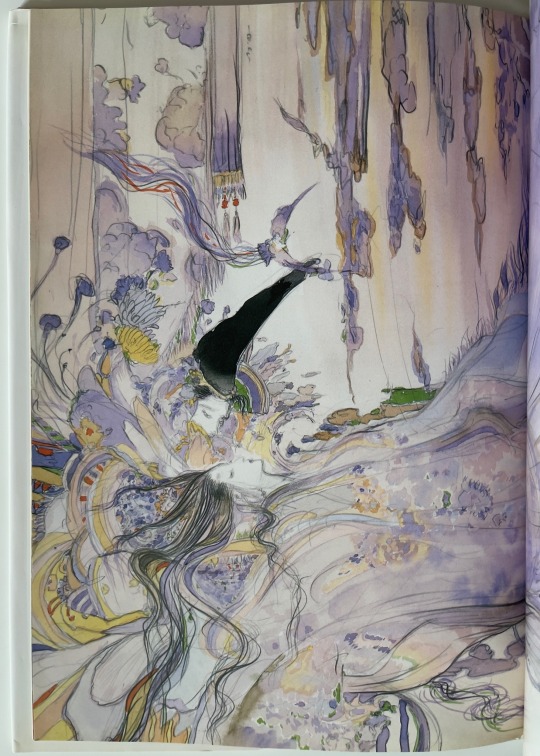
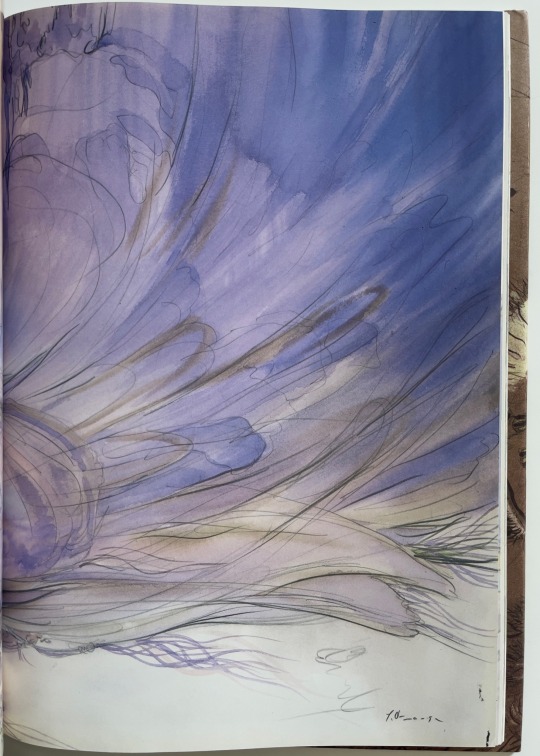
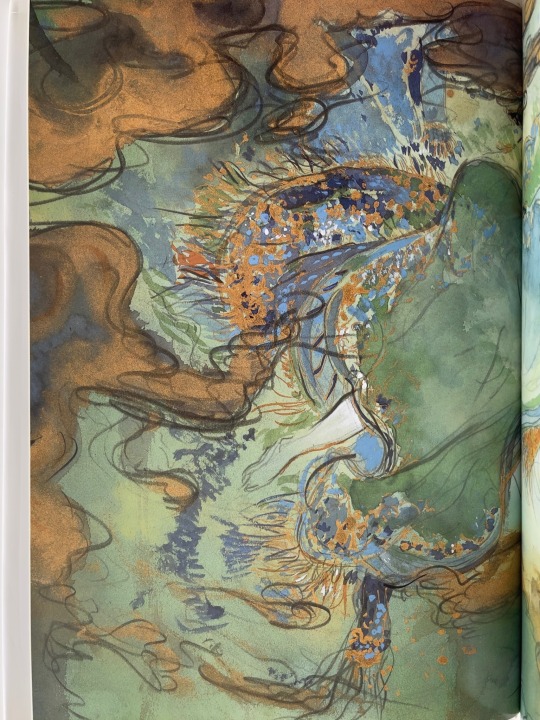

Yoshitaka Amano: The Tale of Genji (2006)
1K notes
·
View notes
Note

Hello! i saw your kimono drawing guide, and i have some questions.
I saw this art and was wondering about a few things:
what is the tied knot& tassel things on the sleeves for?
and, what hairstyle is the lady wearing?
If you know, please tell me!
If you don't know, could it be possible to direct me to someone that might? Thank you for taking the time to answer, if you're able! Have a lovely night/day!
Hi and thank you for your question :) The ukiyoe you are sharing is by Utagawa Kunisada and titled Genji rokujo no hana (源氏六條の花), or "Cherry Blossoms at Genji's Rokujô Mansion". It is part of a three prints set:

It depicts an imaginary scenery from The tale of Genji, and the young lady playing with her pet cat is the princess Onna San no Miya.
Characters are not shown wearing period accurate clothes (from Heian era), but luscious Edo period attires. Because of her rank, the young princess is wearing what Edo princesses would, especially the trademark hairstyle named fukiya 吹輪.
You'll find below a translation from a costume photobook I did a while ago. Note the big bridge style front hairpin, and the drum like one in the back. Princesses from the buke (samurai class) would also have dangling locks called aikyôge (I also found the term okurege), but I am not sure kuge princesses (noble class) wore them too.

There is a whole dispute about this hairstyle, as we are not actually sure it was worn as such by actual princesses. This style may have in fact started as a somehow cliché bunraku/kabuki costume used to depict princesses (think a bit like Western Cinderella-types princess gowns). Nowadays, it is found only as a theater style, or worn by Maiko during Setsubun season.
For comparison, here is character Shizuka Gozen from kabuki play Yoshitsune Senbon Zakura:

As for the dangling cords, I covered those in a past ask about kamuro that you can find here (part 1 / part 2). TL:DR: I am still not sure what is the exact name for those decorations (kazari himo? sode no himo?).
But their use is pretty much linked to 3 things:
1) luck + protection (knots have auspicous meanings),
2) reinforcing weak points of garnment (here: sleeves wrist opening)
3) cuteness impact, as much like furisode (long sleeves kimono) those dangling ribbons were mostly seen on girls/young unmarried ladies by the Edo period
All the design elements chosen by Utagawa Kunisada for his Onna San no Miya stress own young and carefree she is still (which considering her narrative arc is in fact a bit sad... like all Genji Monogatari stories). BUT: bonus points for pet cat!
Hope that helps :)
#japan#kimono#ask#fashion history#art history#ukiyoe#The tale of Genji#genji monogatari#Utagawa Kunisada#hime#princess#onna San no Miya#nihongami#japanese hairstyle#fukiya#katsuyama#kazari himo#sode no himo#dangling ribbon#kamuro#kumihimo#ribbon#cord
483 notes
·
View notes
Photo

The Tale of Genji - Wakana by Okada Yoshio (1970′s)
#okada yoshio#art#woodblock print#woodblock prints#fine art#1970s#1970s art#showa era#showa period#japanese art#japanese artist#princess#the tale of genji#asian art#classic art
1K notes
·
View notes
Text

I’m still just getting my thoughts together on The Tale of Genji by Lady Murasaki Shikibu, translated by Edward G. Seidensticker, which was an epic that took me by surprise. Considered by many to be the first known novel, written in the early 11th century in Japan by a woman at court, this book is full of drama, wit, poetry, and messiness.
Genji is his father’s favorite. A beautiful, naturally charming prince, he is considered to be too good to be true—there was an idea that if too beautiful, you would be doomed to die early. His father is unable to name him crown prince due to court politics, and so he is a commoner at court, but one of tremendous influence. Genji is in love with love, and chases after women left and right—but is very serious about these affairs, making it a point not to abandon the women he seduces. It is a story of romance, intrigue, and growth.
One thing I was surprised by is the modern-feeling self-awareness of the text. Many analyses identify the 2nd protagonist, Kaoru, as possibly the first anti-hero, but I’d argue Genji is. Like many early mythic figures, he is loved by all but not without flaws. When he adopts (kidnaps) Lady Murasaki at a young age specifically to groom her into a future wife, the text does not shy away from how inappropriate it is. Characters disapprove, and the text is often cynical or wry about Genji’s choices. It does the same when Genji’s seductions turn coercive. It forgives Genji, but does excuse him, and that was something I did not expect from such an early text. This reflectiveness is part of what makes the book feel like a novel, rather than an epic poem of some kind.
#the tale of genji#murasaki shikibu#books in translation#classic literature#japanese literature#my book reviews#tale of genji
51 notes
·
View notes
Text

32 notes
·
View notes
Photo
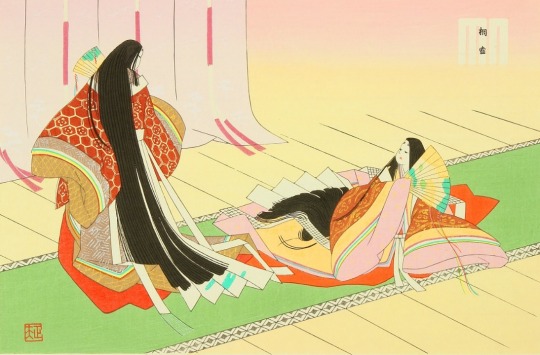
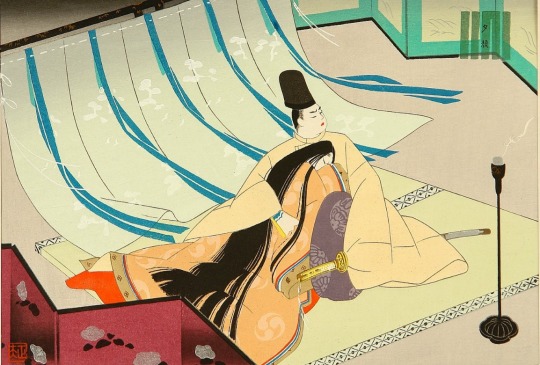
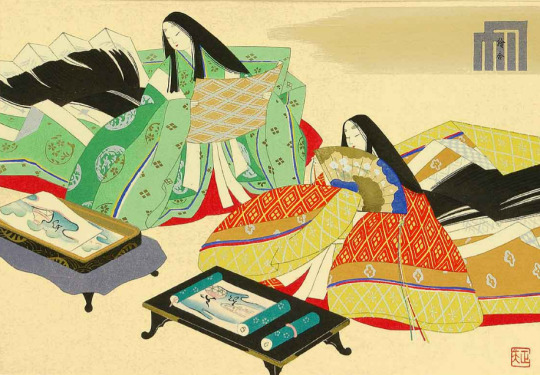

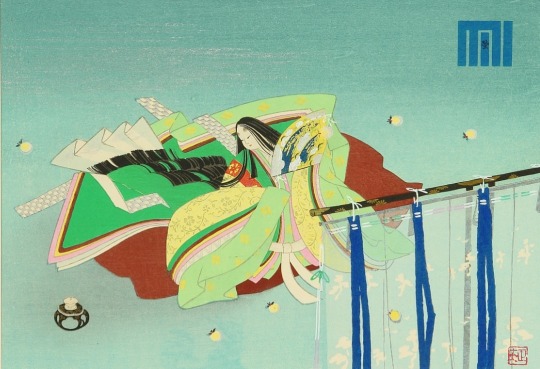
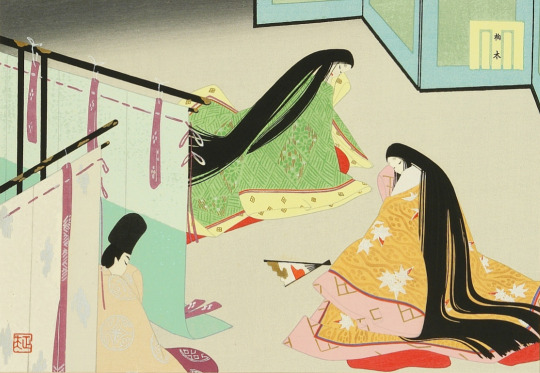
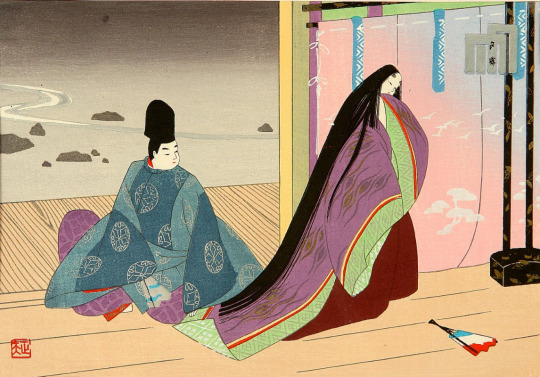
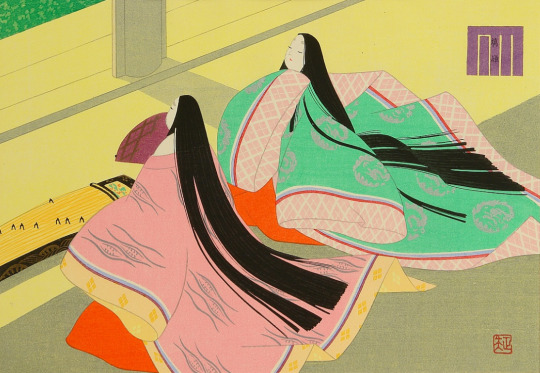

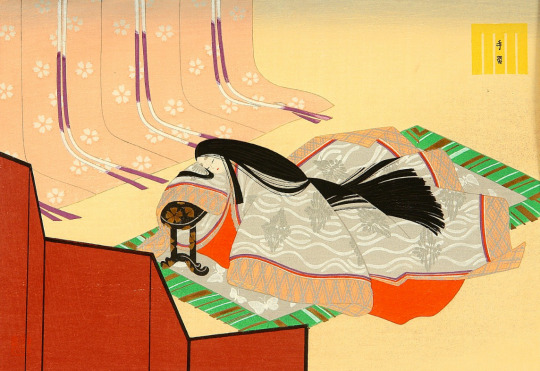
Scenes from “The Tale of Genji” - beautifully illustrated by Maeda Masao, ca. 1950
(click on image to see the chapters and characters depicted)
#the tale of genji#genji monogatari#murasaki shikibu#heian#era#period#japanese#history#literature#world literature#classics#illustration#illustrations#ukiyoe#fashion history
407 notes
·
View notes
Note
You said once that Heian is a story rich with Tale of Genji intertextuality as it is Tsukihime intertextuality. From someone who hasn't read it, what other instances of this in action can you expand upon?
I might been missing a few pieces since it's been a couple years since I read Heian and a few years more for The Tale of Genji, but these are the parallels that stood out to me.
1/
I guess I should start by explaining what I meant in my previous post. So, The Tale of Genji is a heavy long-runner series covering from the circumstances behind Hikaru Genji's birth to the major events of his son's life after his death. And the major early chapters of Hikaru's life are about him courting many different women in an attempt to ultimately choose his wife.
You probably know that Hikaru Genji is a controversial figure. This is true in the story, to the people of the time, and even more so to the people of our time. And the main source of Genji's discourse is his arguably main wife, Murasaki no Ue. What's important to understand about Hikaru is that despite his divisiveness, Murasaki Shikibu's narrative voice always described him as the perfect man. That character is her ideal no matter how much the characters and readers disagree. And the first chapter, the one before Hikaru's birth, establishes that he is the perfect man because his mother Kiritsubo no Koi was the perfect woman. Lady Kiritsubo dies between the first two chapters and that's when Hikaru's quest for a wife begins.
One of the relatively early wife-candidates-of-the-week is Fujitsubo. Her gimmick is straight-up samefaceing. Fujitsubo is the perfect woman because she's somehow a palette-swapped second coming of Kiritsubo. Hikaru obviously wants her but his father obviously also wants her because she's Lady Kiritsubo 2, and it's the dad who gets her because he's the emperor while Hikaru is an illegitimate prince not in line for the throne. With their social status preventing a real relationship, the 18-year-old Hikaru Genji started his relationship with Fujitsubo's 10-year-old niece Murasaki, in whom he saw the budding image of a future new Fujitsubo (Kiritsubo 3?).
Tsuna's backstory in FGO Heian is pretty much all built on references to this character trio. Tsuna came across a woman described word-for-word as "beautiful enough to be taken as the Emperor's wife" and instantly fell in love with her but couldn't actualize this love due to social class differences. Later Tsuna meets Ibaraki, recognizes the woman's face on the younger girl, and is nice to her because he likes seeing "that face" happy. Tsuna's and Ibaraki's relationship can be interpreted as a non-romantic version of The Tale of Genji's main couple, but I can't shake off the grooming undertones that come from its inspiration, and even if I could, the idea of Ibaraki being used as a proxy for her mother is still creepy regardless.
2/
One important thing about The Tale of Genji is that it's the oldest novel we know of, so its earliest chapters were instrumental in popularizing novels as a format. For context, The Tale of Genji had a periodic release format, with each chapter being published as its own separate scrolls, so later chapters were published after the public had read the previous ones and their social impact was already tangible to the author.
One of the most memorable sections of The Tale of Genji (meaning more memorable to me specifically than generally notorious) comes in one of the middle chapters, I'll guess around chapter 25. In this scene, Hikaru Genji catches his wife Murasaki reading a novel. Hikaru parrots the time's popular opinion Genji-spawned novel trend: that prose is literature for dumb people and that only poetry has real value. Murasaki, as the character with the author's name would, verbally tears him apart with a big speech explaining what prose can do that poetry can't and how this new form of literature has just as much potential and value as the poetry classics.
In one of the first chapters when Kintoki's party is crashing at Murasaki's house, there's a similar conversation, where Kintoki tells Murasaki (author) about the things that a writer can do that a warrior like him can't, raising many similar points to Murasaki (character).
3/
Nagiko got a short section giving out her Tale of Genji opinions. It's mostly a repeat of her comments at her debut event's epilogue, but it is there. The whole motivation for her boss fight is that she loves the books' cheery and vibrant depictions of romance despite Hikaru being an unbearable character (based and correct).
Could be related to Hikaru Genji having too many love interests, in contrast to Sei Shounagon's very "one and only" views of romance.
4/
Speaking of a character's whole motivation in the plot, let's talk about Murasaki's. She's a funny character that gets a lot funnier with full context. The Heian Singularity/Lostbelt is set in a time when Murasaki Shikibu had already published many chapters of The Tale of Genji and caused a major cultural phenomenon. The whole capital was crazy to know what would happen next and this pressure gave her immense writer's block. So she fought in the Holy Grail War, risking her life for a chance to wish for the perfect conclusion to Hikaru Genji's story. She lost but Babbage gave her new motivation to write with her own hands the perfect conclusion that her perfect man deserves.
So? What's the conclusion Murasaki writes for Hikaru without any magical interference? You see, The Tale of Genji in its final form is comprised of 55 scrolls, each released separately as one chapter. The 42nd of these scrolls is Hikaru's death chapter. After 41 chapters deriving world-changing popularity, how did the genius Murasaki Shikibu close his story? With boldness and commitment to the bit. See, to Murasaki's authorial voice, Hikaru Genji is too hot and perfect. So hot and perfect that his death is too monumental of a tragedy to be possibly put into words. Thus, Murasaki published an entirely blank scroll and in the next one, Hikaru Genji was inexplicably dead.
Hikaru's death is my favorite thing about the Tale of Genji, not only for getting rid of the worst boy but mainly for the narrative power move that is still as insane writing for today's standards as it was back when it was published in the first novel ever. But this moment of genius is also a perfect thing to turn into a writer's block joke. Easily one of my best contenders for Sakurai's funniest joke.
27 notes
·
View notes
Text
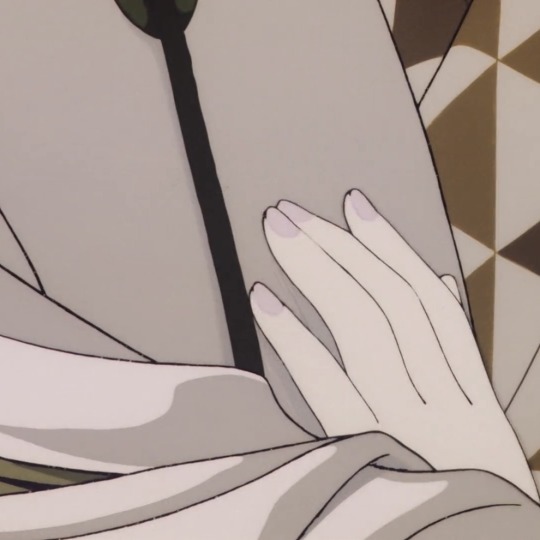

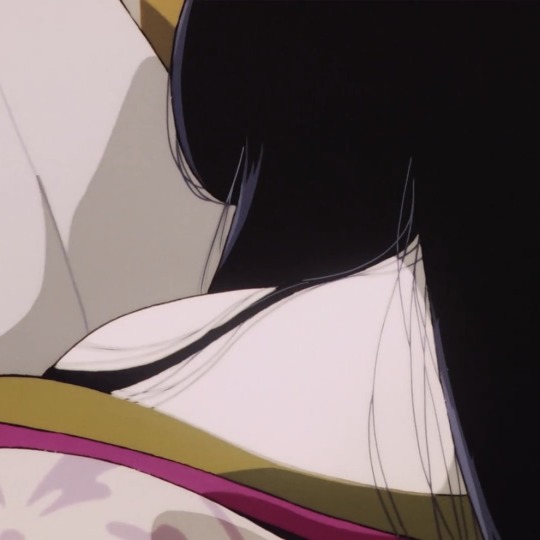

Genji Monogatari(1987), directed by Sugii Gisaburo

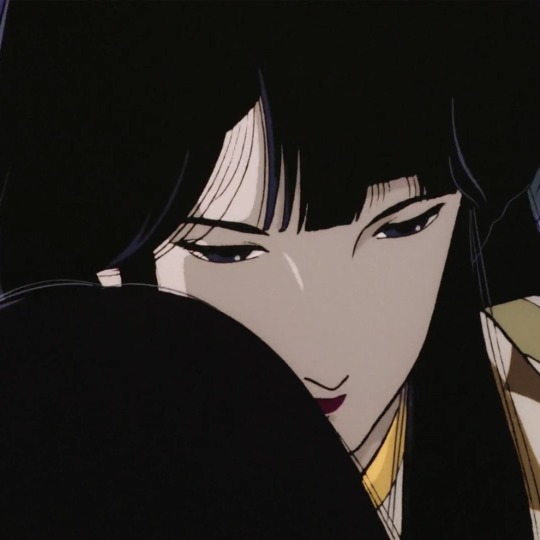

#Genji Monogatari#The Tale of Genji#Sugii Gisaburo#retro anime#aesthetic icons#moodboard#Genji Monogatari 1987#cinema
21 notes
·
View notes
Text




Ohitorisama (Ep 1)
#ohitorisama#party of one#mizuki alisa#alisa mizuki#japanese drama#j drama#jdrama#dorama#japan#asian drama#the tale of genji#murasaki shikibu
10 notes
·
View notes
Text

Taki Shusui (Japanese, b. 1938), Kumoi no kari from Tale of Genji, color woodblock print, signed Shusui, 10¾ × 15¾ in., 27.3 × 40 cm.
137 notes
·
View notes
Photo


Uemura Shōen
Flame (Honoo). 1918
#uemura shōen#color on silk#nihonga#bijin-ga art#the tale of genji#taisho period#japanese culture#women artists#tokyo national museum#art detail
149 notes
·
View notes
Text
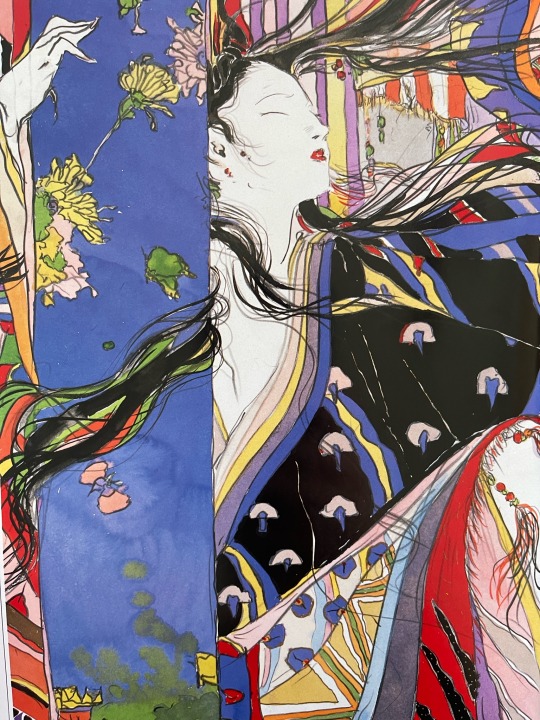
Yoshitaka Amano: The Tale of Genji (2006)
716 notes
·
View notes
Text
youtube
First birthday stream announcement!!
It's finally here! The long awaited Genji Monogatari powerpoint video!
It took me a year to finally edit and post, but the stream has been cut to half its length to make my powerpoint the best watching experience possible, with added fact checking notes and edits!
It didn't make the birthday premiere, but I also have someone adding closed captions, and I hope to add chapters to the video as well! Whether you're interested in Heian Era classical literature or just like to listen to people passionately ramble about niche subjects, it'll be a really fun video!
7 notes
·
View notes
Text



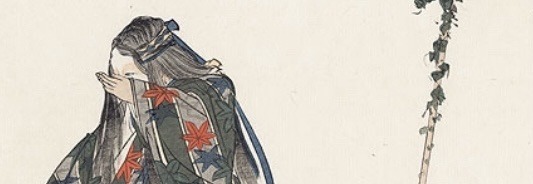

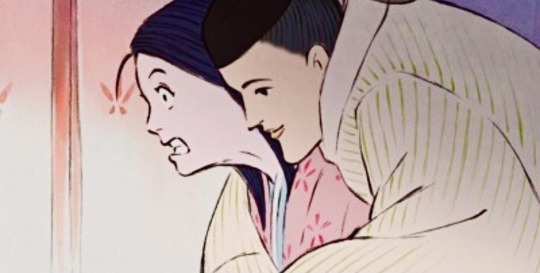
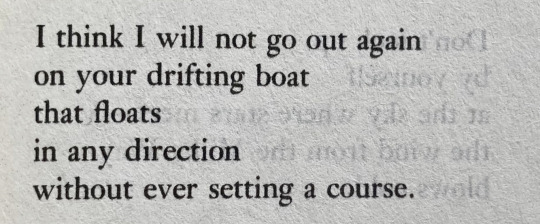



Women rejecting male suitors in premodern Japanese literature
‘Sotoba Komachi’ (14th century) by Kan'ami Kiyotsugu, trans. Donald Keene • Scene from It Was a Faint Dream (1974) dir. Akio Jissôji (based on Towazugatari (1306) by Lady Nijo) • The Tale of Genji (~1010) by Murasaki Shikibu, trans. Royall Tyler • Detail from Unai appearing as a young maiden (from Motomezuka, Act 1) by Tsukioka Kogyo (1900) • The Tale of the Bamboo Cutter (9th century) by Anonymous, trans. Donald Keene • Kaguya rejecting the emperor in The Tale of Princess Kaguya (2013) dir. Isao Takahata (based on The Tale of the Bamboo Cutter) • Untitled poem by Izumi Shikibu (11th century) trans. Jane Hirshfield and Mariko Aratani • Kagero Nikki (~974) by Michitsuna’s Mother, trans. Donald Keene • Utsusemi from "Fifty-four Chapters of The Tale of Genji” (1852) by Utagawa Hiroshige • Untitled poem (9th century) by Sosei, trans. Kenneth Rexroth
#classical japanese literature#japanese literature#japanese poetry#books#literature#classical literature#medieval#medieval literature#web weaving#ellis reads#the tale of genji#izumi shikibu#murasaki shikibu#ono no komachi#tale of genji#genji monogatari#sosei#the tale of the princess kaguya#i was thinking about how unusual it is to find a classical literary culture that so prominently features female rejection of male courtship#it appears in so many places. young women rejecting elegible suitors. wives rejecting husbands. lower rank women rejecting princes.#female rejection became a key part of the social and literary code#these rejections weren’t always respected by the suitors or condoned by the authors writing them or those around them#but they were nevertheless recorded and thus immortalised#and so we can remember michitsune’s mother not just as a passive victim of a patriarchal system but as one who asserted her agency to say no#circumstances made her powerless in many ways but she still exists and asserts her selfhood through her memoirs#it’s just. incredible and humbling#also ik Ukifune isn’t anywhere on this but she was the inspiration for it <3 thinking about her always
213 notes
·
View notes
Text


“Such a difficult, constricted life as a woman was required to live! Moving things, amusing things, she must pretend to be unaffected by them. With whom was she to share the pleasure and beguile the tedium of this fleeting world? Since it chose to look upon women as useless, unfeeling creatures, should it not pity the fathers who went to such trouble rearing them? Like the mute prince who was always appearing in sad parables, a woman should be sensitive but silent. The balance was certainly difficult to maintain.”—from the perspective of Lady Murasaki in Tale of Genji
I’m so glad I read all of the Tale of Genji. It was dense but rarely difficult reading, full of intense romantic and family drama. It was moving, funny, infuriating, and fascinating in turn. The characters had all the complex reality of a historical tv drama, and the translator did an excellent job of keeping the text both rich and accessible. And I continue to be thrilled and happy that the first novel—and what a novel!—was written by a woman, and that her text went without equal for many, many years.
I made a chart showing all of the connections between the characters that was immensely helpful. Names can be a little tricky, as women don’t use their personal names at this time and so are referred to as “the 3rd princess” or “the lady of the evening faces” in the text. It didn’t help that some online guides and translations Anglicize some of these names in ways that can be confusing in a quick google search.
But my chart helped. If you’re interested in reading Genji, please hit me up for my chart! I have a fewer-spoilers version for the 1st chunk of the text, and then the full one that technically has spoilers but is also a full and complete guide to the characters you’ll need to know.
#tale of genji#murasaki shikibu#the tale of genji#japanese literature#books in translation#translated literature#my book reviews
20 notes
·
View notes
Text
if you enjoy “Sex In the City” (1998-2004 A.D.) or perhaps “True Blood” (2008-2014 A.D.)
you may also enjoy “Genji Monogatari” (c. 1000 A.D.)
#this is mostly joking. mostly.#I just adore the world’s oldest recorded fictional fuckboy#sex in the city#genji monogatari#the tale of genji#true blood
11 notes
·
View notes